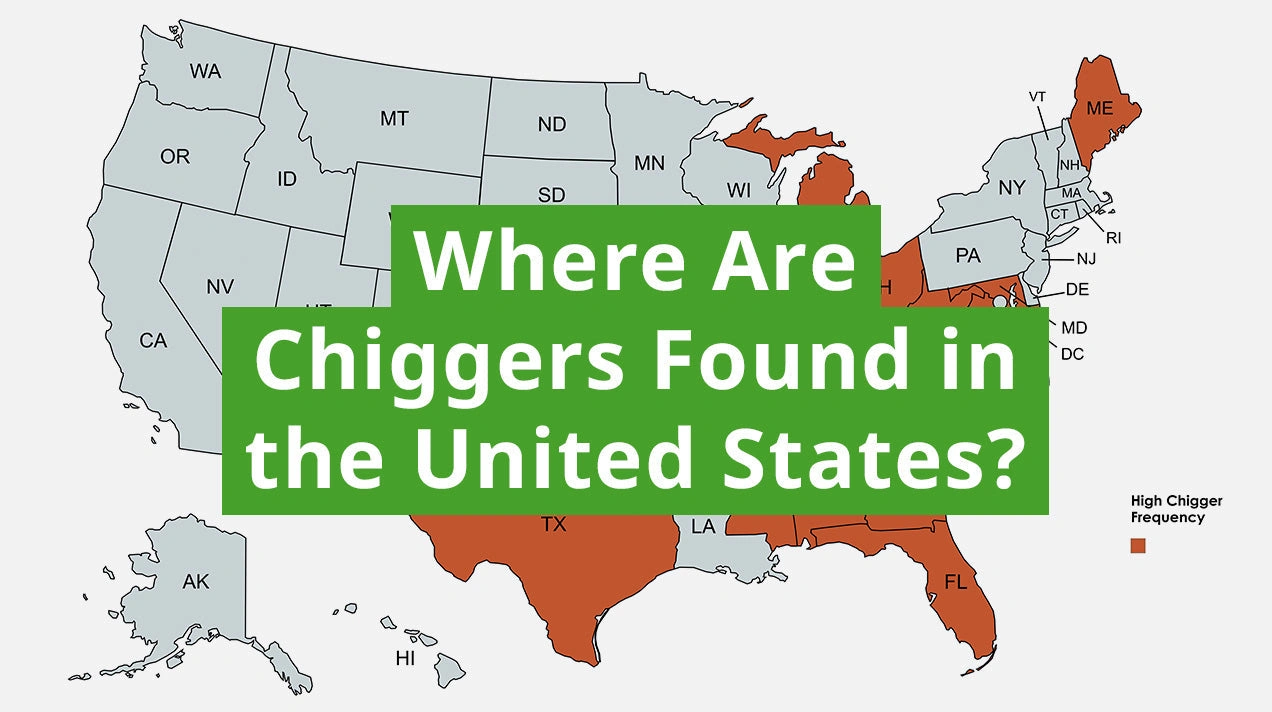
Chiggers in Winter? Seriously?
Picture this: It’s December. You’re bundled up for a nature walk, dog bounding ahead, and you’re savoring the bite in the air. You’re thinking—mosquitoes? Gone. Ticks? Snoozing. Every annoying bug, safely off-duty until spring. Right? Well … not exactly. (Go ahead, scratch your ankle. I won’t judge.)
A few winters ago, I learned this the, uh, itchy way. I’d spent an afternoon clearing brush in the backyard—a rare mild Georgia winter day—and that night, yowza. Tiny red welts showed up along my socks and waistband. Chiggers? In winter? Turns out, in certain states, those little mites weren’t about to let a chilly forecast cramp their style.
Where Do Chiggers Even Hang Out?
So, let’s set the scene. Chiggers—the baby stage of a type of mite—are so tiny you’ll never spot them unless you’re really trying. They love the kinds of places where your shoes get soaked with dew and your arms brush past wild grass—think gardens, overgrown lawns, the edge of the woods.
But here’s the kicker: they’re not picky about location, just about the climate. According to research on chigger habitats, they thrive in warm, humid areas, especially where brush and tall grass meet a bit of moisture. Mostly, they’re just waiting around for someone (like, ahem, us) to pass by.
Now, when it gets cold—like, really cold—they vanish from sight. Chiggers become inactive below around 60°F, and the itchy ones can’t survive if the ground temperature drops below about 42°F. Ouch for them, but a relief for the rest of us up north.
So Are They Everywhere?
Kind of. Turns out, chiggers are found in all 50 states, but that doesn’t mean every winter hike is a hazard. The hotter and muggier, the higher the risk. Missouri? Yup, big chigger country in summer, but not a winter worry. Florida? Texas? Arkansas? That’s where we start raising our chigger antennae all year round—especially if the season is warmer than usual.
If you’re ever curious about your neck of the woods, there’s this handy What states have chiggers in the winter map that paints the whole continental picture nicely, breaking down which states stay riskier when the temps drop.
Why Some States Stay Itchy
So, why aren’t chiggers just an everybody-loses-every-winter situation? It comes down to climate and micro-climates. Warmer, milder winters—think Texas, Louisiana, parts of Alabama—don’t get cold enough to wipe out chigger populations completely. Instead, adult chiggers burrow underground and larvae hang out dormant in the leaf litter, just waiting for a decent sunny day.
Down south, “winter” is a little … optimistic. Sometimes it’s more like a chilly, slightly less-muggy fall. Which means chiggers can sometimes perk up with just a week or two of warm snaps.
When Do Chiggers Give Up?
Once those frosty nights really hit, chiggers clock out. In states with true hardwood winters—Nebraska, Minnesota, Maine—you can pretty much let your guard down from November through late March. But in the milder zones, especially if there’s been some rain, all it takes is a mild patch and boom: one jog in the tall grass, and it’s red dots city.
True story: A friend of mine in Oklahoma had to stop hiking in a favorite preserve until February, after realizing that even in January, a spell of warm rain could kick-start those pesky chiggers again. I guess Mother Nature just refuses to give some people a break!
Let’s Get Specific: States That Still See Chiggers in Winter
Now for the juicy bit—what states have chiggers in the winter? According to state-by-state chigger reviews and tons of folks with (very itchy) first-hand experience, here’s the winter watchlist:
- Texas (big surprise!): Mild, unpredictable winters—especially in coastal and eastern regions—let chiggers stick around most years. For a deep dive on sneaky winter chigger action, check out What states have chiggers in the winter in texas.
- Florida: If you’re down there for “winter” sunshine, chiggers could easily sneak a bite, especially in marshy or overgrown spots.
- Louisiana and Mississippi: Warm ground, damp air, thick grass…yeah, you see where this is going.
- Alabama, Arkansas, Georgia, Oklahoma: These states may freeze up now and then, but in the patchy spots and during warm spells, chiggers can stick it out through most of the year.
If you’re curious about your favorite hiking state, that What states have chiggers in the winter map is super handy—and kinda fun to compare with your own shivers and itch stories.
What About The Rest of the Country?
Honestly, in states where winter actually feels like winter, chiggers are a non-issue. Montana, Michigan, Vermont … you’re off the hook till things warm up. In those states, adults stay tucked away underground till the first real spring thaw.
Quick Comparison Table: Where Chiggers Are Sleeping vs. Lurking
| State/Region | Winter Chigger Activity | Comments |
|---|---|---|
| Texas, Florida, Deep South | Low but persistent (dormant/active during mild spells) | Risk after rain or unseasonably warm weather—protect your ankles! |
| Midwest (MO, OK, AR) | Tiny risk in the south; almost none in north and central areas | Rare unless winter is unusually warm and damp |
| Northeast, Upper Midwest | Inactive/dead from first frost till spring | Scratch your itches elsewhere—no chiggers here till May! |
What Do Winter Chigger Bites Look and Feel Like?
Okay, so here’s what you’ll notice if you’re “lucky” enough to meet a winter chigger: the bites look the same as summer ones, but they always feel about three times as annoying. Probably because, mentally, you weren’t expecting it. The welts are almost always in lines or clusters—ankles, waist, behind your knees, even your armpits (don’t laugh, it happens).
The biggest myth? Chiggers don’t burrow into your skin. They just inject a little enzyme that makes your skin cells dissolve (gross, yes, but also weirdly fascinating), and your immune system freaks out—hence the mad itching. You’ll only spot the actual red chigger if you’ve got like, superhero vision.
Bites can last up to two weeks if you’re unlucky and love to scratch. (Speaking from experience. Oops.)
What If I Get Bitten—Right in the Middle of Winter?
First, don’t panic. Chigger bites almost never lead to disease (in North America, anyway). But, yeah, keep your fingernails away…scratching just makes it worse.
- Wash the area with soap and water, as soon as you notice the bites.
- Apply a cold compress if it feels hot or super itchy.
- Hydrocortisone cream or a calamine lotion can be a lifesaver.
- For major outbreaks, an oatmeal bath or some allergy meds might help you sleep.
If you’re curious about how others handle these little monsters, there’s a great breakdown in What states have chiggers in the winter in texas. Every region has its own home remedy, it seems!
Table: My Go-To Itch Relief (Tested & Loved)
| Bite Stage | Relief Method | Why It Works |
|---|---|---|
| Early Itch | Cold compress, soap and water | Stops spread, cools skin, reduces urge to claw yourself raw |
| Full-on Rash | Calamine or hydrocortisone cream | Calms down your body’s overreaction—less swelling, less pain |
| Can’t Stop Scratching | Oatmeal bath, antihistamines | Soothes skin, chills out the histamine response so you can sleep |
Keeping Chigger-Free, Even in Milder Winters
You’re probably wondering: If I live somewhere winter isn’t really all that cold, am I doomed? Do I just wrap up like a mummy every time I walk the dog? Thankfully, no. A few simple tweaks and chiggers are back to being a summertime annoyance, not a year-round terror.
- Wear long pants and sleeves for brushy walks—even on “winter” days that feel like April.
- Mow grass short and rake leaves in fall (trust me, chiggers love messy lawns).
- Stick to main trails, especially in parks and nature reserves.
- If you’ve had mild, rainy weather, spritz boots and ankles with a little DEET or permethrin—even in January.
In Texas, chiggers sometimes persist in shady, protected yards or low wetlands all year long, so those simple tricks really do matter. If you’re a visual person, scroll through the What states have chiggers in the winter map before your next adventure.
Real Talk: Why Chiggers Give Me the Creeps
Okay, honest moment? The first chigger attack I ever got was after a totally innocent game of tag in late November, at my grandma’s in Louisiana. I thought I’d escaped every bug for the season. But what do you know—I was wrong. I joked that I brought home “living proof” not all bugs get the winter vacation memo. So if you’ve ever spent a winter scratching and wondering “is this even possible?”—you’re in good company.
Wrapping Up: Your Action Plan For a Chigger-Smart Winter
So. What states have chiggers in the winter? Mostly the southern, balmy ones—think Texas, Florida, Louisiana, and parts of Oklahoma and Georgia—where winter feels like a polite suggestion rather than a real season. If you live where snow and ice are the norm, you’re in the clear. But for everyone else, keep an eye out during warm snaps, and don’t neglect your bug-prep even when the holidays hit.
The trick is staying savvy—use that What states have chiggers in the winter map as a quick gut check, and peek at What states have chiggers in the winter in texas if you’re spending time down south. A few easy habits—long pants, bug spray, raked lawns—make all the difference. If you do get a mystery rash, don’t panic. Clean up, treat the itch, and maybe share your chigger tale (we’ve all got one).
Me? I still love winter hikes … just with a little extra fabric between me and that dewy grass. Your turn: how do you keep bugs at bay when it’s supposed to be “off” season? Got a weird, itchy story of your own? Share it below. And hey—here’s to a winter full of adventure, not scratching!


















Leave a Reply
You must be logged in to post a comment.